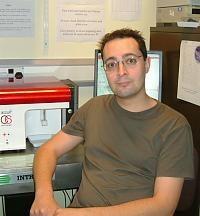Research
We investigate how cell death affects the local tissue environment and in particular how necrosis drives sterile inflammation. We have a special interest in the pathogenesis of atherosclerotic plaques, which are characterized by chronic inflammation and an accumulation of apoptotic and necrotic cells. Much of our work focuses on the key inflammatory cytokine IL-1α, which acts as a powerful danger signal upon release from dead cells. However, our recent work has shown that an elaborate molecular system controls IL-1α in a conditional and cell type-dependent manner to prevent inappropriate activation. In addition, we also investigate the basic mechanisms that control IL-1α and IL-1β secretion and novel factors that control these pathways.
Specific areas of research:
- Intracellular IL-1R2 controls IL-1α: IL-1R2 has a signal peptide that targets it for secretion. However, lots of IL-1R2 is cytosolic, where it inhibits IL-1α activity. We are investigating what cell-type specific mechanisms control this mislocalisation.
- Role of IL-1α and IL-1R2 in atherosclerosis: IL-1 appears to play a key role in atherosclerosis. We are determining how IL-1R2 controls inflammation after necrotic death of cells within the plaque
- Can IL-1R2 lessen graft rejection: Rejection of experimental vessel grafts is driven by damaged endothelial cell-derived IL-1α.
- Failed phagocytosis in atherosclerosis: A key pathway that leads to necrosis is the failure of phagocytosis. What factors cause this?
- Senescence driven inflammation: Cells undergo senescence within plaques, but they are thought to be inactive cells. We are investigating how senescent cells actively drive inflammation and plaque growth.
Publications
Death is coming and the clot thickens, as pyroptosis feeds the fire. Burzynski LC, Clarke MCH. Immunity. 2019; 50, 1339-1341.
The coagulation and immune system are directly linked through the activation of interleukin-1α by thrombin. Burzynski LC, Humphry M, Pyrillou K, Wiggins KA, Chan JNE, Figg N, Kitt LL, Summers C, Tatham KC, Martin PB, Bennett MR, Clarke MCH. Immunity. 2019; 50, 1033–1042.
IL-1α cleavage by inflammatory caspases of the non-canonical inflammasome controls the senescence-associated secretory phenotype. Wiggins KA, Parry AJ, Cassidy L, Webster SJ, Humphry M, Goodall JC, Narita M, Clarke MCH. Aging Cell. 2019; 18(3):e12946.
Vascular smooth muscle cells in atherosclerosis. Basatemur B, *Jorgensen H, *Clarke MCH, Bennett M, Mallat Z. Nature Revs Cardio. 2019 10.1038/s41569-019-0227-9. (Invited review). *Joint 2nd authors.
Senescence utilises inflammatory caspases to drive the SASP. Wiggins KA, Clarke MCH. Aging. 2019; 11(12): 3891–3892.
Platelet isolation and activation assays. Burzynski LC, Pugh N, Clarke MCH. Bio-protocol. 2019. In Press.
Bennett MR, Clarke MCH. Killing the old: cell senescence in atherosclerosis. Nature Revs Cardio. 2017; 14, 8-9.
Wang J, Uryga AK, Reinhold J, Figg N, Baker L, Finigan A, Gray K, Kumar S, Clarke MCH, Bennett M. Vascular Smooth Muscle Cell Senescence promotes Atherosclerosis and Features of Plaque Vulnerability. Circulation. 2015; 132(20):1909-19.
Burzynski LC, Humphry M, Bennett MR, Clarke MCH. Interleukin-1α activity in necrotic endothelial cells is controlled by caspase-1 cleavage of interleukin-1 receptor-2; implications for allograft rejection. J Biol Chem. 2015; 290: 25188-96.
Gardner SE, Humphry M, Bennett MR, Clarke MCH. Senescent vascular smooth muscle cells drive inflammation through an interleukin-1α-dependent senescence-associated secretory phenotype. ATVB. 2015; 35(9):1963-74.
Maguire JJ, Jones KL, Kuc RE, Clarke MCH, Bennett MR, Davenport AP. The CCR5 chemokine receptor mediates vasoconstriction and stimulates intimal hyperplasia in human vessels in vitro. Cardiovas Res. 2013; 101(3):513-21.
Yu E, Calvert PA, Mercer JR, Harrison J, Baker L, Figg NL, Kumar S, Wang JC, Hurst LA, Obaid DR, Logan A, West NE, Clarke MCH, Vidal-Puig A, Murphy MP, Bennett MR. Mitochondrial DNA damage can promote atherosclerosis independently of reactive oxygen species through effects on smooth muscle cells and monocytes and correlates with higher-risk plaques in humans. Circulation. 2013; 128(7):702-12.



